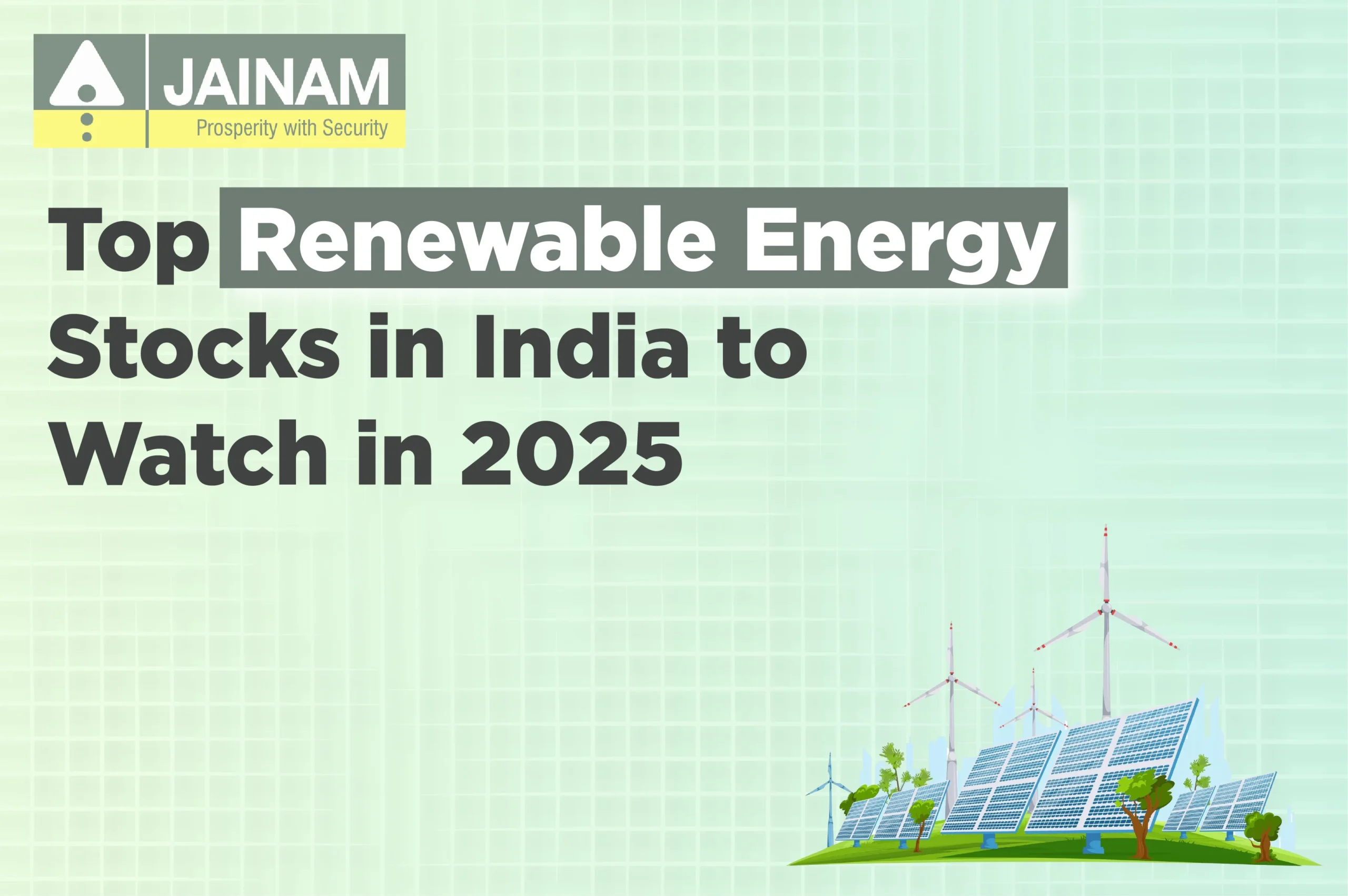
[ad_1]

Introduction
India is powering up its green dreams with renewed determination. As global attention intensifies on sustainable energy solutions, the green energy sector in India is evolving from an alternative into a mainstream force. The shift isn’t just happening on policy papers or at summits, it’s visible on rooftops fitted with solar panels, on highways lined with EV charging stations, and in rural landscapes transformed by wind farms. For investors, this shift is opening up exciting avenues in renewable energy stocks in India, making them one of the most talked-about investment themes for the future.
Renewable energy in India is attracting massive attention not just for its climate impact, but for its strong financial promise. The Indian renewable energy share price of several listed companies has witnessed heightened activity in recent quarters, reflecting growing interest from both domestic and international investors.
With India targeting 500 GW of non-fossil fuel capacity by 2030, the renewable energy sector in India is poised for substantial growth. Whether you’re someone who tracks the Indian renewable energy share price daily, or you’re exploring green stocks for long-term wealth creation, 2025 is shaping up to be a pivotal year.
In this blog, we’ll unpack the key drivers of the renewable energy boom, highlight some of the best renewable energy stocks to keep on your radar, and explain why renewable energy stocks in India are not just good for the planet; they could be great for your portfolio.
Why Focus on Renewable Energy Stocks in 2025?
From global climate goals to national ambitions, renewable energy in India is no longer just a buzzword, it’s a movement. India aims to achieve 500 GW of non-fossil fuel capacity by 2030. That means solar panels on more rooftops, wind turbines across landscapes, and a massive shift in power generation. For investors, renewable energy stocks in India provide a front-row seat to this transition.
Plus, with the government offering incentives, subsidies, and robust policies, the renewable energy sector is attracting institutional and retail interest alike. The result? A dynamic, high-impact investment space.
Top Renewable Energy Stocks in India to Watch in 2025
1. NTPC Ltd
Market Cap: ₹ 3,39,771 Cr.
NTPC Ltd (National Thermal Power Corporation), along with its subsidiaries, associates, and joint ventures, primarily focuses on generating and supplying bulk power to state utilities. The group also engages in consultancy services, project management and supervision, energy trading, coal mining, and oil & gas exploration.
Pros
- The company has been maintaining a healthy dividend payout of 39.5%.
2. Power Grid Corporation of India Ltd
Market Cap: ₹ 2,73,345 Cr.
About:
Power Grid Corporation of India Limited is a Maharatna Central Public Sector Undertaking (CPSU) and the country’s largest electric power transmission company. As of March 31, 2021, the Government of India holds a 51.34% stake in the company. Established in 1989, PGCIL was formed to develop extra-high voltage AC and high-voltage DC (HVDC) transmission infrastructure.
The company is responsible for transmitting large volumes of electricity from central generating stations and power-surplus regions to demand centres across and within states. It operates under the administrative control of the Ministry of Power, Government of India.
In addition to its core transmission business, PGCIL undertakes critical projects nominated by the government and is actively involved in the planning, execution, operation, and maintenance of the Inter-State Transmission System (ISTS). The company also provides telecom and consultancy services.
Pros
- Stock is providing a good dividend yield of 3.83%.
- The company has been maintaining a healthy dividend payout of 65.0%.
3. Adani Power Ltd
Market Cap: ₹ 2,05,401 Cr.
About:
Adani Power Limited (APL), a key entity within the diversified Adani Group, stands as India’s largest private-sector thermal power producer. Through its subsidiaries, the company sells electricity generated from its power projects via a mix of long-term Power Purchase Agreements (PPAs), short-term PPAs, and merchant sales.
Pros
- The company has delivered good profit growth of 88.5% CAGR over the last 5 years.
- The company has a good return on equity track record: 3 Years ROE 47.8%.
- Debtor days have improved from 106 to 84.6 days.
4. Adani Green Energy Ltd
Market Cap: ₹ 1,46,333 Cr.
About:
Adani Green Energy Limited (AGEL), established in 2015, serves as the holding company for multiple subsidiaries engaged in renewable energy generation across the Adani Group. The company focuses primarily on solar and wind power projects, along with related activities, playing a pivotal role in driving large-scale renewable energy initiatives and contributing significantly to India’s clean energy landscape.
Pros
- The company has delivered good profit growth of 36.1% CAGR over the last 5 years.
- Debtor days have improved from 95.1 to 53.1 days.
5. Tata Power Company Ltd
Market Cap: ₹ 1,17,892 Cr.
About:
Tata Power Company Ltd is primarily involved in the business of the generation, transmission & distribution of electricity. It aims to produce electricity completely through renewable sources. It also manufactures solar roofs and plans to build 1 lakh EV charging stations by 2025[1]. The company is India’s largest vertically-integrated power company.
Pros
- The company has delivered good profit growth of 74.2% CAGR over the last 5 years.
- The company has been maintaining a healthy dividend payout of 22.8%.
6. Adani Energy Solutions Ltd
Market Cap: ₹ 1,03,238 Cr.
About:
Adani Energy Solutions Limited (AESL), a part of the Adani portfolio, operates across multiple segments of the energy sector, including power transmission, distribution, smart metering, and cooling solutions. Holds the distinction of being India’s largest private-sector power transmission company.
Pros
- The company is expected to give a good quarter.
7. JSW Energy Ltd
Market Cap: ₹ 88,507 Cr.
About:
JSW Energy Ltd, along with its subsidiaries, is primarily involved in power generation through its assets located in Karnataka, Maharashtra, Nandyal, & Salboni. Serving as the holding entity for the JSW Group’s power segment, the company also holds interests in a joint venture focused on mining operations and an associate company engaged in turbine manufacturing. JSW Energy Ltd is committed to renewable energy production through its various power assets, contributing to India’s sustainable energy goals.
Pros
- The company has delivered good profit growth of 19.8% CAGR over the last 5 years.
- The company has been maintaining a healthy dividend payout of 20.1%.
- Debtor days have improved from 37.0 to 26.8 days.
8. NHPC Ltd
Market Cap: ₹ 83,414 Cr.
About:
NHPC Limited, a Mini Ratna Category I public sector enterprise, is the Government of India’s leading hydroelectric power generation company. Its core business involves generating and supplying bulk power to various power utilities. NHPC is also engaged in project management, construction contracts, consultancy services, and power trading.
Pros
- The company has been maintaining a healthy dividend payout of 50.6%.
- The company’s working capital requirements have reduced from 84.4 days to 29.5 days.
9. NTPC Green Energy Ltd
Market Cap: ₹ 81,474 Cr.
About:
Incorporated in April 2022, NTPC Green Energy is a renewable energy company that focuses on undertaking projects through organic and inorganic routes.
Pros
- Debtor days have improved from 416 to 131 days.
10. Torrent Power Ltd
Market Cap: ₹ 77,452 Cr.
About:
Torrent Power Ltd is a leading integrated power utility company in India with presence across generation, transmission, and distribution of power. Its operations are spread across the states of Gujarat, Maharashtra, Uttar Pradesh, and Karnataka.
It is a part of Torrent Group, which has presence across the pharmaceutical, power, and city gas distribution business.
Pros
- The company has been maintaining a healthy dividend payout of 65.4%.
Open free demat account in 5 minutes
Sector Overview: Renewable Energy Sector in India
India’s renewable energy sector has experienced remarkable growth, driven by robust policy support, technological advancements, and a commitment to sustainable development. As of December 2023, the country’s installed renewable energy capacity, excluding large hydro projects, stood at approximately 135 GW. Projections indicate an increase to 170 GW by March 2025, reflecting a significant expansion in clean energy adoption.
The government’s ambitious target aims for 500 GW of non-fossil fuel capacity by 2030, underscoring India’s dedication to transitioning towards a greener energy mix.
Beyond energy generation, the focus has expanded to include storage solutions, efficient distribution, and bolstering domestic manufacturing capabilities. This comprehensive approach is vital for integrating renewable energy solutions into the national grid and reducing reliance on imported energy technologies.
Key trends shaping India’s renewable energy landscape include:
1. Massive Solar Park Developments:
States such as Gujarat, Rajasthan, and Tamil Nadu are leading in large-scale solar park developments. Notably, the Bhadla Solar Park in Rajasthan has achieved a total installed capacity of 2,245 MW, making it one of the largest solar parks globally.
2. Wind Corridor Expansions in Coastal States:
Coastal regions, particularly Gujarat and Tamil Nadu, are harnessing their wind energy potential through significant corridor expansions. These developments contribute substantially to the national grid and support the diversification of India’s energy portfolio.
3. Push for Green Hydrogen and EV Infrastructure:
The Indian government launched the National Green Hydrogen Mission in early 2023, aiming to position the country as a global hub for green hydrogen production and export. The mission targets the development of at least 5 million metric tonnes of green hydrogen production capacity per annum by 2030. Concurrently, efforts to expand electric vehicle (EV) infrastructure are evident, with 25,202 public EV charging stations installed across the country as of December 2024.
These developments highlight the vast potential within India’s renewable energy sector, offering significant opportunities for investors and contributing to the nation’s sustainable energy future.
Factors to Consider When Investing
Before you jump into buying a renewable energy stock, it’s important to go beyond the headlines and dig into the fundamentals. Here are some key factors to guide your investment decisions in the renewable energy sector:
1. Policy Support:
India’s renewable energy sector is highly policy-driven. Central and state governments frequently roll out schemes, subsidies, and incentives to push green energy adoption. For example, initiatives like the Production Linked Incentive (PLI) Scheme for solar module manufacturing and viability gap funding for hybrid renewable projects can significantly impact the profitability and growth of companies. Staying updated on government announcements is essential, as policy changes can either accelerate or stall a company’s trajectory.
2. Financial Health & Balance Sheets:
While the sector is brimming with opportunity, not all companies are on equally strong financial footing. Some are heavily leveraged, which could pose risks during economic slowdowns or interest rate hikes. Look for companies with healthy cash flows, manageable debt, and a track record of profitability. A closer look at the balance sheet will reveal if a company can weather delays in project approvals or payment cycles from discoms (distribution companies).
3. Scalability & Execution Capacity:
In a capital-intensive industry like renewable energy, size and scalability matter. Companies with land banks, signed Power Purchase Agreements (PPAs), and a strong execution pipeline are in a better position to expand rapidly. Whether it’s ramping up solar parks or building wind farms across states, operational capability directly translates into revenue visibility. Review the company’s past performance in executing projects and meeting deadlines. Investors should consider building a renewable energy portfolio that includes a mix of solar, wind, and other green energy stocks to mitigate risks and maximise returns.
4. Technological Edge:
Technology is increasingly becoming a differentiator in the renewable energy landscape. From AI-driven energy forecasting systems to advanced solar tracking mechanisms and battery storage innovations, companies investing in smart tech are positioning themselves for long-term success. A firm’s adoption of automation, grid integration solutions, and digital energy monitoring can enhance both efficiency and cost-effectiveness, making it more attractive to investors.
Performance & Price Trends
Understanding green energy stock price movement can help identify entry and exit points. Here’s a quick snapshot:
- Adani Green Energy: Peaked in 2022, corrected in 2023, now stabilising with fresh buying interest.
- JSW Energy: Consistent upward movement with strong institutional support.
- KPI Green Energy: Mid-cap rally player with frequent news-based movements.
These share prices often react to regulatory news, quarterly results, and new project wins.
Benefits of Investing in Renewable Energy Stocks
Investing in green energy stocks isn’t just about ethical satisfaction, it’s about long-term strategic gains. Here’s why more investors are turning to renewable energy stocks:
1. Sustainable Returns:
The global transition toward clean energy is irreversible, and India is leading from the front. With demand rising steadily, renewable energy companies are enjoying steady cash flows and increasing project orders, making them capable of delivering reliable, long-term returns.
2. Portfolio Diversification:
Traditional energy sectors such as oil and gas are often volatile and exposed to geopolitical tensions. Renewable energy stocks offer diversification by tapping into a different segmentone that’s driven by technology, innovation, and long-term government backing.
3. ESG Compliance:
Environmental, Social, and Governance (ESG) standards are becoming essential for modern portfolios. By investing in Indian renewable energy, you not only support the environment but also align with global ESG mandates that institutional investors are increasingly prioritising.
4. Subsidies & PLI Benefits:
Government support in the form of Production Linked Incentives (PLI), capital subsidies, and renewable purchase obligations (RPOs) reduces business risk and ensures a smoother cash flow cycle for companies, increasing investor confidence.
Challenges in the Renewable Energy Sector
No sector is without its hurdles, and the renewable energy sector in India is no exception. Investors need to be aware of the following challenges:
1. Land Acquisition Delays:
Acquiring land for solar parks or wind farms, especially at scale, can be difficult due to regulatory bottlenecks, community pushback, or unclear ownership. These delays can slow down project execution and affect revenue timelines.
2. Policy Uncertainty:
While the central government is aggressive in its renewable agenda, policy shifts at the state level can create confusion. Sudden tariff renegotiations, delayed approvals, or changes in power purchase agreements (PPAs) can lead to legal complications and revenue hits.
3. Grid Integration Issues:
Renewable power, especially solar and wind, is intermittent. Integrating it into the main grid without destabilising supply is a technical challenge. Until India has robust storage and smart grid capabilities in place, this will remain a key concern.
4. High Initial Costs:
Setting up renewable energy infrastructure requires significant upfront capital. Though operational costs are low, the high capex can be a barrier for new players or investors looking for quicker returns.
Understanding these challenges equips investors to make informed, long-term decisions—balancing risks with the growing opportunities in the renewable energy stock space. Investors should also be cautious when considering renewable energy penny stocks, as these low-cost investments can be highly volatile and carry additional risks.
Future Outlook: What to Expect in 2025 & Beyond
India’s renewable energy sector is poised for significant transformations in 2025 and beyond. With increased budget allocations and growing global investor interest, several key developments are anticipated: The increasing focus on solar energy stocks reflects the growing importance of solar power in India’s renewable energy landscape.
1. Surge in Renewable Energy IPOs
The renewable energy landscape in India is witnessing a notable uptick in initial public offerings (IPOs). Companies like Premier Energies and Waaree Energies have successfully raised approximately $850 million through their IPOs, reflecting robust investor confidence. Additionally, electric vehicle manufacturers such as Ather Energy and Ola Electric have secured substantial funds, indicating a broader trend of clean energy enterprises tapping into public markets. This momentum suggests a conducive environment for more renewable energy firms to go public shortly.
2. Increased Foreign Institutional Investor (FII) Participation
Foreign institutional investors have been instrumental in channeling capital into India’s renewable energy sector. Between April 2020 and September 2023, the sector attracted $6.1 billion (approximately ₹50,000 crore) in FDI equity investments, underscoring global confidence in India’s green energy trajectory. This trend is expected to continue, with FIIs playing a pivotal role in financing upcoming renewable projects.
3. Enhanced Valuation Metrics and Greater Retail Interest
The renewable energy sector has seen fluctuating valuations, with periods of rapid growth followed by corrections. For instance, revenue multiples for green energy companies peaked at 11.1x in Q4 2020 but experienced a decline in subsequent years. As the market matures and companies demonstrate consistent performance, valuation metrics are expected to stabilise, attracting more retail investors seeking sustainable investment opportunities.
4. Expansion of Green Hydrogen Initiatives
The Indian government has launched the National Green Hydrogen Mission with an initial outlay of ₹19,744 crore up to 2029-2030, aiming to make India a global hub for green hydrogen production, utilisation, and export. This initiative is anticipated to create investment opportunities across the green hydrogen value chain, further diversifying the renewable energy sector.
5. Integration with Electric Vehicle (EV) Infrastructure
The synergy between renewable energy and the burgeoning EV market is becoming increasingly evident. India’s public EV charging network expanded from 1,800 stations in 2022 to over 12,146 in 2024, driven by government policies and private sector participation. This integration is crucial for promoting sustainable transportation solutions and is likely to spur further investments in both sectors.
How to Start Investing
Getting started with renewable energy stocks in India doesn’t have to be overwhelming. Here are a few simple steps to help you begin your journey:
When selecting stocks, consider the track record and growth potential of each green energy company to make informed investment decisions.
Use a Stock Screener:
Platforms like Tickertape and Screener.in help you filter stocks based on sector, market cap, financial ratios, and more. You can also explore tools provided by Jainam Broking, such as SmartDelta, which offers strategy backtesting, market analytics, and derivatives insights ideal for more active investors. For quick trades and real-time updates, Jainam Lite offers a seamless and intuitive trading experience.
Follow the News:
Keep tabs on policy changes, budget announcements, and global sustainability initiatives. Regulatory shifts can have an immediate impact on renewable energy share prices.
Review ROE & PE Ratios:
Look at Return on Equity (ROE) and Price-to-Earnings (PE) ratios to assess a company’s financial performance and whether its stock is fairly valued.
Start Small:
If you’re new to equities, consider starting with mutual funds or ETFs that focus on renewable energy in India. It’s a great way to gain exposure without diving directly into individual stocks.
Conclusion
As India charges ahead toward its clean energy goals, the renewable energy sector in India presents an exciting space for both seasoned and new investors. With a strong policy push, accelerating technology adoption, and increasing foreign and domestic interest, renewable energy stocks in India are becoming essential portfolio considerations.
Whether you’re tracking the Indian renewable energy share price regularly or just starting to explore the space, 2025 is poised to be a landmark year. But more than timing the market, understanding the underlying trends and making informed choices is key.
That’s where platforms like Jainam Broking Ltd. can empower you. With tools like SmartDelta and Jainam Lite, the firm combines research expertise and seamless technology to help you screen, analyse, and invest smarter in this evolving space. If you’re serious about aligning your portfolio with the future, it’s time to plug into India’s green power story with the right knowledge and support.
So, are you planning on trading in the stock market? If yes, you are at the right place!
Open a Demat Account with Jainam Broking Ltd. Now!
[ad_2]
publish_date]








